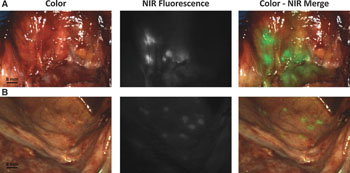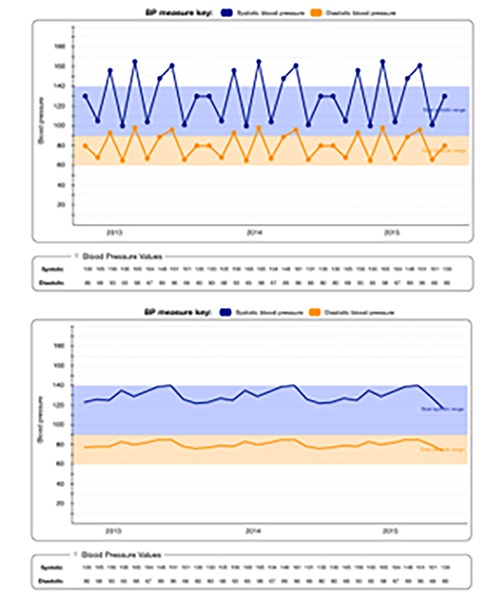Tumor-Specific Imaging Agent Helps Resect Ovarian Cancer
|
By HospiMedica International staff writers Posted on 29 Jun 2016 |

Image: An intraoperative detection of ovarian cancer metastases using fluorescence-based imaging (Photo courtesy of LUMC).
A novel contrast agent for intraoperative near-infrared (NIR) fluorescence imaging can help surgeons detect nearly 30% more ovarian tumor tissue, according to a new study.
Developed by researchers at Leiden University Medical Center (LUMC, The Netherlands), the new, tumor-specific agent, called OTL38, is a combination of a NIR fluorescent dye and a folate analog. A dedicated imaging system is used to identify the fluorescent signal generated after the agent binds to a protein called folate receptor-alpha (FRα), which is expressed in more than 90% of ovarian cancers, but in much lower levels in healthy tissue. Since NIR light at 796 nm penetrates centimeters-deep into tissue, surgeons can use OTL38 to visualize tumors under the surface of the tissue.
In a randomized, double blind, placebo-controlled clinical trial, the researchers administered OTL38 to 12 patients who had epithelial ovarian cancer and were scheduled for cytoreductive surgery. They measured tolerability and blood pharmacokinetics, as well as the ability to detect the tumor. The results showed that OTL38 accumulated in both FR-α tumors and metastases, enabling the surgeons to resect an additional 29% of malignant lesions that were not identified using inspection or palpation. The study was published on June 15, 2106, in Clinical Cancer Research.
“Surgery is the most important treatment for ovarian cancer, and surgeons mainly have to rely on their naked eyes to identify tumor tissue, which is not optimal,” said lead author Alexander Vahrmeijer, MD, who heads the image-guided surgery group at LUMC. “A limitation of this study is that we cannot say yet what the impact of our findings is on cure or survival of the patients. It is reasonably plausible to assume that if more cancer is removed the survival will be better.”
Folate can be used like a Trojan horse to sneak an imaging agent or drug into a cancer cell; ovarian cancer has one of the highest rates of FR-α receptor expression. Approximately 80% of endometrial, lung, and kidney cancers, and 50% of breast and colon cancers also express the receptor.
Related Links:
Leiden University Medical Center
Developed by researchers at Leiden University Medical Center (LUMC, The Netherlands), the new, tumor-specific agent, called OTL38, is a combination of a NIR fluorescent dye and a folate analog. A dedicated imaging system is used to identify the fluorescent signal generated after the agent binds to a protein called folate receptor-alpha (FRα), which is expressed in more than 90% of ovarian cancers, but in much lower levels in healthy tissue. Since NIR light at 796 nm penetrates centimeters-deep into tissue, surgeons can use OTL38 to visualize tumors under the surface of the tissue.
In a randomized, double blind, placebo-controlled clinical trial, the researchers administered OTL38 to 12 patients who had epithelial ovarian cancer and were scheduled for cytoreductive surgery. They measured tolerability and blood pharmacokinetics, as well as the ability to detect the tumor. The results showed that OTL38 accumulated in both FR-α tumors and metastases, enabling the surgeons to resect an additional 29% of malignant lesions that were not identified using inspection or palpation. The study was published on June 15, 2106, in Clinical Cancer Research.
“Surgery is the most important treatment for ovarian cancer, and surgeons mainly have to rely on their naked eyes to identify tumor tissue, which is not optimal,” said lead author Alexander Vahrmeijer, MD, who heads the image-guided surgery group at LUMC. “A limitation of this study is that we cannot say yet what the impact of our findings is on cure or survival of the patients. It is reasonably plausible to assume that if more cancer is removed the survival will be better.”
Folate can be used like a Trojan horse to sneak an imaging agent or drug into a cancer cell; ovarian cancer has one of the highest rates of FR-α receptor expression. Approximately 80% of endometrial, lung, and kidney cancers, and 50% of breast and colon cancers also express the receptor.
Related Links:
Leiden University Medical Center
Latest Surgical Techniques News
- DNA Origami Improves Imaging of Dense Pancreatic Tissue for Cancer Detection and Treatment
- Pioneering Sutureless Coronary Bypass Technology to Eliminate Open-Chest Procedures
- Intravascular Imaging for Guiding Stent Implantation Ensures Safer Stenting Procedures
- World's First AI Surgical Guidance Platform Allows Surgeons to Measure Success in Real-Time
- AI-Generated Synthetic Scarred Hearts Aid Atrial Fibrillation Treatment
- New Class of Bioadhesives to Connect Human Tissues to Long-Term Medical Implants
- New Transcatheter Valve Found Safe and Effective for Treating Aortic Regurgitation
- Minimally Invasive Valve Repair Reduces Hospitalizations in Severe Tricuspid Regurgitation Patients
- Tiny Robotic Tools Powered by Magnetic Fields to Enable Minimally Invasive Brain Surgery
- Magnetic Tweezers Make Robotic Surgery Safer and More Precise
- AI-Powered Surgical Planning Tool Improves Pre-Op Planning
- Novel Sensing System Restores Missing Sense of Touch in Minimally Invasive Surgery
- Headset-Based AR Navigation System Improves EVD Placement
- Higher Electrode Density Improves Epilepsy Surgery by Pinpointing Where Seizures Begin
- Open-Source Tool Optimizes Placement of Visual Brain Implants
- Easy-To-Apply Gel Could Prevent Formation of Post-Surgical Abdominal Adhesions
Channels
Critical Care
view channel
Breakthrough AI Technology Accurately Assesses Heart Failure Severity
Heart failure (HF) is a complex condition where the heart cannot effectively pump blood to meet the body’s needs due to underlying medical issues. It is marked by recurring episodes and frequent hospitalizations.... Read more
New Approach to Visualizing Blood Pressure Data Can Help Better Manage Hypertension Patients
Sometimes, a patient’s blood pressure may be elevated in a doctor's office but normal at home, a phenomenon known as white coat hypertension. It is estimated that 10% to 20% of high blood pressure diagnoses... Read morePatient Care
view channel
Portable Biosensor Platform to Reduce Hospital-Acquired Infections
Approximately 4 million patients in the European Union acquire healthcare-associated infections (HAIs) or nosocomial infections each year, with around 37,000 deaths directly resulting from these infections,... Read moreFirst-Of-Its-Kind Portable Germicidal Light Technology Disinfects High-Touch Clinical Surfaces in Seconds
Reducing healthcare-acquired infections (HAIs) remains a pressing issue within global healthcare systems. In the United States alone, 1.7 million patients contract HAIs annually, leading to approximately... Read more
Surgical Capacity Optimization Solution Helps Hospitals Boost OR Utilization
An innovative solution has the capability to transform surgical capacity utilization by targeting the root cause of surgical block time inefficiencies. Fujitsu Limited’s (Tokyo, Japan) Surgical Capacity... Read more
Game-Changing Innovation in Surgical Instrument Sterilization Significantly Improves OR Throughput
A groundbreaking innovation enables hospitals to significantly improve instrument processing time and throughput in operating rooms (ORs) and sterile processing departments. Turbett Surgical, Inc.... Read moreHealth IT
view channel
Printable Molecule-Selective Nanoparticles Enable Mass Production of Wearable Biosensors
The future of medicine is likely to focus on the personalization of healthcare—understanding exactly what an individual requires and delivering the appropriate combination of nutrients, metabolites, and... Read more
Smartwatches Could Detect Congestive Heart Failure
Diagnosing congestive heart failure (CHF) typically requires expensive and time-consuming imaging techniques like echocardiography, also known as cardiac ultrasound. Previously, detecting CHF by analyzing... Read moreBusiness
view channel
Expanded Collaboration to Transform OR Technology Through AI and Automation
The expansion of an existing collaboration between three leading companies aims to develop artificial intelligence (AI)-driven solutions for smart operating rooms with sophisticated monitoring and automation.... Read more

















